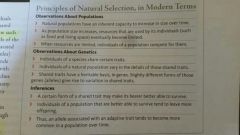![]()
![]()
![]()
Use LEFT and RIGHT arrow keys to navigate between flashcards;
Use UP and DOWN arrow keys to flip the card;
H to show hint;
A reads text to speech;
33 Cards in this Set
- Front
- Back
- 3rd side (hint)
|
Change heritable characteristics of populations over successive generations. Gives rise to diversity |
Evolution |
Change in a line of descent. |
|
|
Mechanism of evolution in which minor genetic changes occur in populations over generations and finally produce enough genetic variation to create a new species of an organism. |
Gradualism |
Small biological changes over time. |
|
|
Evolutionary process by which new biological species arise. |
Speciation |
|
|
|
long periods of no or little change followed by sudden change. |
Punctuated Equilibrium |
|
|
|
Differential survival and reproduction of individuals of a population based on differences in shared, heritable traits. Driven by environmental pressures. |
Natural Selection |
|
|
|
Study of patterns in the geographic distribution of species and communities |
Biogeography |
|
|
|
The scientific study of similarities and differences in body plans. |
Comparitive Morphology |
|
|
|
Physical evidence of an organism that lived in the ancient past. |
Fossil |
|
|
|
A heritable trait that enhances an individual's fitness in a particular environment. |
Adaptation (adaptive trait) |
|
|
|
Change in a line of descent |
Evolution |
|
|
|
Degree of adaptation to an environment, as measured by an individual's relative genetic contribution to future generations. |
Fitness |
|
|
|
Line of descent |
Lineage |
|
|
|
Differential survival and reproduction of individuals of a population based on differences in shared, heritable traits. Driven by environmental pressures. |
Natural Selection |
|
|
|
Chracteristic time it takes for half of a quantity of a radioisotope to decay. |
Half-life |
|
|
|
Supercontinent that existed before Pangea, more than 500 million years ago. |
Gondwana |
|
|
|
Method of estimating the age of a rock or fossil by measuring the content and proportions of a radioisotope and it's daughter elements. |
Radiometric Dating |
|
|
|
Supercontinent that formed about 270 million years ago. |
Pangea |
|
|
|
Theory that earth's outer layer of rock is cracked into plates, the slow movement of which rafts continents to new locations over geologic time. |
Plate Tectonics Theory |
|
|
|
Chronology of earth's history. Correlates geological and evolutionary events of the ancient past. |
Geologic Time Scale |
|
|
|
Similar body structures that evolved separately in different lineages. |
Analogous Structures |
|
|
|
Body structures that are similar in different lineages because they evolved in a common ancestor. |
Homologous Structures |
Different use, similar structure |
|
|
Evolutionary pattern in which similar body parts evolve separately in different lineages. |
Morphological Convergence |
|
|
|
Evolutionary pattern in which a body part of an ancestor changes in its descendants |
Morphological Divergence |
|
|
|
Differential success in survival and reproduction within a population |
Natural Selection |
|
|
|
Believed that species are fixed and do not evolve and that all forms of life are arranged on a scale of complexity. |
Aristotle |
|
|
|
Believed that earth's surface has changed by finding fossils of seashells on mountainsides. Proposed theory of catastrophism to explain extinction. |
George Cuvier |
Flasely Believed the Earth to be thousands of years old. |
|
|
Advocated that life evolves and proposed that environmental pressures cause an internal need for change that occur through use and misuse of body parts. |
Jean Baptiste Lamarck |
Proposed acquired characteristics are inherited. |
|
|
Developed "gradualism"/"uniformity theory" which stated that the earth had changed slowly and what we see today is the result of gradual changes over millions of years. |
Charles Lyell |
Wrote "The principles of Geology" |
|
|
An economist who proposed the idea of limited resources within a population. Human reproduction can exceed capacity of environment to sustain them. |
Thomas Malthus |
Correlated decreases in the size of human populations with episodes of disease, famine and war. |
|
|
Unnatural selective pressure by breeding individuals with desirable traits over many generations. |
Artificial Selection |
Example: humans breeding dogs from wolves, and selecting variations of parts of the wild mustard to create cabbages, kale, broccoli, etc. |
|
|
Developed his theory about evolution by natural selection independently from Darwin in 1858 |
Alfred Russel Wallace |
|
|
|
Darwin's main idea that living species have descended from earlier life forms and that species change over time. |
Descent with Modification (Evolution) |
|
|
|
Mechanism by which evolution occurs. |
Natural selection |

|

